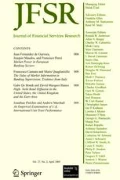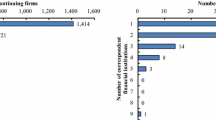Abstract
Using unique small business credit-file data from a major Finnish bank, I analyze how relationship characteristics are associated with loan interest rates. Data includes the effective loan rate and variables that describe the duration and scope of relationship, collateralization, firm characteristics, bank’s internal risk rating, and loan characteristics. The results show that longer duration tends to lower the cost of credit and that a long-term bank/firm relationship is beneficial especially to high-risk firms. As the relationship matures, the loan premiums for high-risk firms decrease at higher rate than for low-risk firms.
Similar content being viewed by others
Notes
As a condition of being given access to the loan files of this bank, I have promised confidentiality to the bank and the customers regarding identity and location.
See the correlation matrix in Appendix IV. Requirement of personal guarantee (Pergua) has negative and statistically significant correlation with the maturity of the loan (Maturity). According to the additional probit-regression (not reported), it is likely that the firm has higher internal risk rating when personal guarantee is required.
References
Angelini P, Di Salvo R, Ferri G (1998) Availability and cost of credit for small businesses: customer relationships and credit cooperatives. J Bank Financ 22:925–954
Bank of Finland (2002) Financial markets in Finland. Bank of Finland, ISBN 952-462-091-X
Berger AN, Udell GF (1995) Relationship lending and lines of credit in small business finance. J Bus 68:351–381
Berger AN, Udell GF (1998) The economics of small business finance: the roles of private equity and debt markets in the financial growth cycle. J Bank Financ 22:613–673
Berger AN, Udell GF (2002) Small business and debt finance. In: Acs ZJ, Audretsch DB (eds) Handbook of entrepreneurship. Kluwer, Dordrecht
Blackwell D, Winters D (1997) Banking relationships and the effect of monitoring on loan pricing. J Financ Res 20:275–289
Bodenhorn H (2003) Short-term loans and long-term relationships: relationship lending in Early America. J Money Credit Bank 35:485–506
Boot AW (2000) Relationship banking: what do we know? J Financ Intermed 9:7–25
Boot AW, Thakor AV (1994) Moral hazard and secured lending in an infinitely repeated credit market game. Int Econ Rev 35:899–920
Brick IE, Kane E, Palia D (2003) Evidence of jointness in the terms of relationship lending, Working paper, Rutgers University, July
Caves R, Uekusa M (1976) Industrial organization in Japan. Brookings Institution, Washington DC
Cole RA (1998) The importance of relationships to the availability of credit. J Bank Financ 22:978–982
Crabbe L (1991) Event risk: an analysis of losses to bondholders and ‘Super Poison Put’ bond covenants. J Finance 46:689–706
D’Auria C, Foglia A, Reedtz PM (1999) Bank interest rates and credit relationships in Italy. J Bank Financ 23:1067–1093
Degryse H, Ongena S (2005) Distance, lending relationships, and competition. J Finance 60:231–266
Degryse H, van Cayseele P (2000) Relationship lending within a bank-based system: evidence from european small business data. J Financ Intermed 9:90–109
Elsas R (2005) Empirical determinants of relationship lending. J Financ Intermed 14:32–57
Elsas R, Krahnen JP (1998) Is relationship lending special? Evidence from credit file data in Germany. J Bank Financ 22:1283–1316
Elsas R, Krahnen JP (2002) Collateral, default risk and relationship lending: an empirical study on financial contracting. Working paper. [cited 24.5.2007]. Available from http://www.wiwi.uni-frankfurt.de/schwerpunkte/finance/wp/461.pdf
Greenbaum S, Kanatas G, Venezia I (1989) Equilibrium loan pricing under the bank–client relationship. J Bank Financ 13:221–235
Harhoff D, Körting T (1998) Lending relationships in Germany—empirical evidence from survey data. J Bank Financ 22:1317–1353
Horiuchi T, Packer F, Fukuda S (1988) What role has the ‘main bank’ played in Japan? J Jpn Int Econ 2:159–180
Hyytinen A, Pajarinen M (2002) Small business finance in Finland. A descriptive study. ETLA, The Research Institute of the Finnish Economy, Discussion zapers 812:1–59. ISSN 0781-6847
Machauer A, Weber M (1998) Bank behavior based on internal credit ratings of borrowers. J Bank Finance 22:1355–1383
Mörttinen L (2000) Essays on loan pricing and the credit channel of monetary policy. Research Reports, Kansantaloustieteen laitoksen tutkimuksia 85:1–117. Department of Economics, University of Helsinki
Nakatani I (1984) The role of financial corporate grouping. In: Aoki M (ed) Economic analysis of the Japanese firm. North Holland, New York, NY
Ongena S, Smith DC (2001) The duration of bank relationships. J Financ Econ 61:449–475
Petersen M, Rajan R (1994) The benefits of lending relationships: evidence from small business data. J Finance 49:3–37
Petersen M, Rajan R (1995) The effect of credit market competition on lending relationships. Q J Econ 110:407–433
Sjögren H (1994) Long-term financial contracts in the bank-orientated financial system. Scand J Manag 10:315–330
Weinstein D, Yafeh Y (1998) On the costs of a bank centered financial system: evidence from the changing main bank relations in Japan. J Finance 53:635–672
Acknowledgements
I am grateful for the comments and suggestions made by Takeo Hoshi, Jukka Perttunen, Juha-Pekka Kallunki, Markku Rahiala, Jonathan A. Scott, Hannu Schadéwitz, Sandra Sizer, and anonymous referees. The following foundations supported this work with research grants; Academy of Finland (Finland), American-Scandinavian Foundation (New York, USA), Emil Aaltosen Säätiö (Finland), the Finnish Cultural Foundation (Finland), Ella ja Georg Ehrnroothin Säätiö (Finland), Jenny ja Antti Wihurin rahasto (Finland), Marcus Wallenbergin Liiketaloudellinen Tutkimussäätiö (Finland), Kaupallisten ja teknillisten tieteiden tukisäätiö (Finland), Liikesivistysrahasto (Finland), Osuuspankkiryhmän Tutkimussäätiö (Finland), Oulun yliopiston Tukisäätiö (Finland), Säästöpankkien Tutkimussäätiö (Finland), Tauno Tönningin Säätiö (Finland) and Yrjö Uiton Säätiö (Finland). I greatfully acknowledge these foundations.
Author information
Authors and Affiliations
Corresponding author
Appendices
Appendix I
Multiple Loans Control
Appendix II
Endogeneity Tests
Appendix III
Conventional Rate
Appendix IV
(Correlation Matrix)
Rights and permissions
About this article
Cite this article
Peltoniemi, J. The Benefits of Relationship Banking: Evidence from Small Business Financing in Finland. J Finan Serv Res 31, 153–171 (2007). https://doi.org/10.1007/s10693-007-0009-0
Received:
Revised:
Accepted:
Published:
Issue Date:
DOI: https://doi.org/10.1007/s10693-007-0009-0




